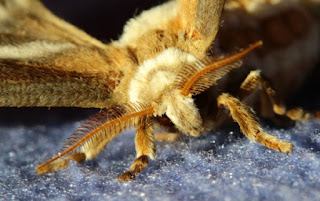
The sequence starts after the moth has emerged from the cocoon - it will climb to try and get in a suitable space where it can hang downwards. This one is hanging from a cocoon (you might notice its not a moon moth cocoon, this is an Atlas cocoon that was hung up in the emerging cage). The wings are really shrivelled to begin with, and very soft. They can be easily damaged at this stage. The moth pumps fluid into the veins and the wings will start to unfold and expand.

Here you can see the forewings and the hindwings expanding. You can start to see the long tails becoming visible too.

Once the wings are pretty much full size, the tails really start to lengthen. You can't quite believe how long those tails are going to become when you see it at this point.

Those tails just seem to keep growing and lengthening ....

I thought the camera was adjusted to the right distance, but those tails are so long, we had to pull back a little further to fit them in to the shot!

So there's the final side view, and just one more front view to show the moth fully emerged. This one is a male - the females have shorter tails and less feathery antennae.

The process you can see here took around an hour in total. Emergence can be a lot quicker in other moths, but those tails take a little while to fully extend. The moths usually emerge in the morning and then sit quiet for the rest of the day, so that the wings have time to harden before evening, when they may well become active and start flying.
There are a lot of things that can go wrong and result in a moth with stunted, shrivelled or deformed wings - it can be due to the caterpillars being inbred or just not very healthy, eating bad quality food, or some disturbance at a crucial stage of its development whilst inside the cocoon, or being too cold or too dry at the point when it begins the process of emergence. Knowing all the things that can potentially go wrong, makes it all the more satisfying to see the process when it goes right.
Now, if one of those female mittrei would emerge, there might be a chance of pairing them!!






































